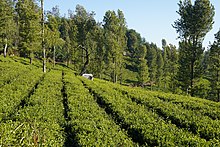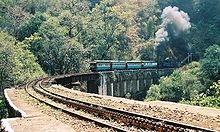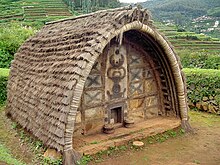Ooty (ⓘ; officially Udhagamandalam, anglicized: Ootacamund (ⓘ), abbreviated as Udhagai) is a town and municipality in the Nilgiris district of the Indian state of Tamil Nadu, 86 km (53 mi) north west of Coimbatore, and the headquarters of the Nilgiris district. In the Nilgiri hills, it is known as the "Queen of Hill Stations" and is a popular tourist destination.
Ooty Ootacamund | |
|---|---|
town | |
| Udhagamandalam | |
| Nickname: Queen of hill stations[1] | |
| Coordinates: 11°25′N 76°42′E / 11.41°N 76.70°E | |
| Country | |
| State | Tamil Nadu |
| Region | Kongu Nadu |
| District | Nilgiris District |
| Government | |
| • Type | Special Grade Municipality |
| • Body | Udhagamandalam Municipality |
| Area | |
| • Total | 30.36 km2 (11.72 sq mi) |
| Elevation | 2,240 m (7,350 ft) |
| Population (2011)[3] | |
| • Total | 88,430 |
| • Density | 2,900/km2 (7,500/sq mi) |
| Demonym(s) | Ootian, Ootacamandian, Udhaghaikaran |
| Languages | |
| • Official | Tamil |
| Time zone | UTC+5:30 (IST) |
| PIN | 643001 |
| Tele | 91423 |
| Vehicle registration | TN-43 |
| Climate | Subtropical Highland (Köppen) |
| Precipitation | 1,100 mm (43 in) |
| Website | tnurbantree.tn.gov.in/ |
Originally occupied by the Toda people, the area came under the rule of the East India Company in the 18th century. It later served as the summer capital of the Madras Presidency. The economy is based on hospitality industry serving tourism and agriculture. The town is connected to the plains by the Nilgiri ghat roads and Nilgiri Mountain Railway.
Etymology
The region was earlier known as Ottakal Mandu, with Otha-Cal meaning "single stone" in Tamil, a reference to a sacred stone revered by the local Toda people and Mandu, a Toda word for "village".[4] This later became Udhagamandalam which was anglicised to Ootacamund by the British, with the first part of the name (Ootaca), a corruption of the local name for the region and the second part (Mand), a shortening of the local Toda word Mandu.[5][6][7] The first known written mention of the place is given as Wotokymund in a letter dated March 1821, written to the Madras Gazette by an unknown correspondent.[8] Ootacamund was later shortened to Ooty. Ooty is in the Nilgiri hills, meaning the "blue mountains", so named due to the Kurunji flower, which used to give the slopes a bluish tinge.[9]
History
The earliest reference to Nilgiri hills is found in the Tamil Sangam epic Silappathikaram from the 5th or 6th century CE.[9] The region was a land occupied by various tribes such as Badagas, Todas, Kotas, Irulas and Kurumbas.[2] The region was ruled by the three tamil kingdoms of Cheras, Cholas and Pandyas during various times.[10][11] The Todas are referenced in a record belonging to Hoysala king Vishnuvardhana and his general Punisa, dated 1117 CE.[12] It was also ruled by various dynasties like Pallavas, Satavahanas, Gangas, Kadambas, Rashtrakutas, Hoysalas and the Vijayanagara empire.[13][14] Tipu Sultan captured Nilgiris in the eighteenth century and the region came into possession of British in 1799.[15] It became part of Coimbatore district of the Madras Presidency.[8]

In 1818, J. C. Whish and N. W. Kindersley, assistants to John Sullivan, then collector of Coimbatore district, visited Kotagiri near Rengaswamy peak. Sullivan established his residence there and reported to the Board of Revenue on 31 July 1819.[9] He also started work on a road from Sirumugai which was completed in May 1823 and extended up to Coonoor between 1830–32. In August 1868, the Nilgiris was separated from the Coimbatore district and James Wilkinson Breeks was appointed its commissioner.[9] On 1 February 1882, Nilgiris was made a district and Richard Wellesley Barlow who was the then commissioner became the first collector of Nilgiris.[8] The region serves as the summer capital of the Madras Presidency and was visited by British officials as a summer retreat.[16] Soldiers were sent to the nearby Wellington to recuperate.[17] After Indian Independence, the town developed into a popular hill resort and Wellington became the home of the Defence Services Staff College of the Indian Army.[18][19]
Geography

Ooty is located in the Nilgiri hills, which form a part of the Western Ghats in the Nilgiri Biosphere Reserve. It is separated from the neighboring state of Karnataka by the Moyar river in the north and from the Anaimalai and Palani hills in the south by the Palghat Gap.[20] It is situated at an altitude of 2,240 metres (7,350 feet) above sea level.[2] The total area of the town is 30.36 km2 (11.72 sq mi).[2] Doddabetta is the highest peak (2,623 km or 1,630 mi) in the Nilgiris, about 10 km (6.2 mi) from Ooty.[21]
Ooty Lake is an artificial lake covering 65 acres (26 ha) created in 1824.[22] Pykara, a river located 19 km (12 mi) from Ooty, rises at Mukurthi peak and flows through a series of cascades with the last two falls of 55 metres (180 ft) and 61 metres (200 ft) known as Pykara falls.[23] Kamaraj Sagar Dam is located 10 km (6.2 mi) from the Ooty.[24] Emerald Lake, Avalanche Lake and Porthimund Lake are other lakes in the region.[25]
Climate
Ooty features a subtropical highland climate (Cwb) under Köppen climate classification.[26] Because of its high altitude, the temperatures are generally lower than the surrounding plains with the average between 10–25 °C (50–77 °F) during summer and 0–21 °C (32–70 °F) during winter.[2] The highest temperature ever recorded was 28.5 °C (83.3 °F) and the lowest temperature was −5.1 °C (22.8 °F).[27] The town gets heavy rainfall during both South-West and North-East monsoons and the average rainfall is about 1,100 millimetres (43 in) of precipitation annually.[2]
| Climate data for Ooty (Udagamandalam) | |||||||||||||
|---|---|---|---|---|---|---|---|---|---|---|---|---|---|
| Month | Jan | Feb | Mar | Apr | May | Jun | Jul | Aug | Sep | Oct | Nov | Dec | Year |
| Mean daily maximum °C (°F) | 20.3 (68.5) | 20.9 (69.6) | 22.2 (72.0) | 22.6 (72.7) | 22.0 (71.6) | 18.3 (64.9) | 16.9 (62.4) | 17.4 (63.3) | 18.4 (65.1) | 18.8 (65.8) | 18.7 (65.7) | 19.7 (67.5) | 19.7 (67.4) |
| Daily mean °C (°F) | 12.4 (54.3) | 13.6 (56.5) | 15.2 (59.4) | 16.3 (61.3) | 16.6 (61.9) | 14.8 (58.6) | 14.1 (57.4) | 14.4 (57.9) | 14.4 (57.9) | 14.6 (58.3) | 13.7 (56.7) | 12.9 (55.2) | 14.4 (58.0) |
| Mean daily minimum °C (°F) | 5.6 (42.1) | 6.5 (43.7) | 8.8 (47.8) | 10.7 (51.3) | 11.4 (52.5) | 11.2 (52.2) | 11.0 (51.8) | 10.9 (51.6) | 10.4 (50.7) | 10.1 (50.2) | 8.6 (47.5) | 6.7 (44.1) | 9.3 (48.8) |
| Average precipitation mm (inches) | 20.5 (0.81) | 10.2 (0.40) | 25.8 (1.02) | 75.4 (2.97) | 147.5 (5.81) | 136.7 (5.38) | 181.1 (7.13) | 123.7 (4.87) | 134.9 (5.31) | 189.2 (7.45) | 139.9 (5.51) | 52.8 (2.08) | 1,237.7 (48.74) |
| Average rainy days | 1 | 1 | 2 | 5 | 8 | 8 | 10 | 9 | 9 | 11 | 7 | 4 | 75 |
| Mean daily sunshine hours | 8 | 8 | 8 | 8 | 7 | 4 | 4 | 4 | 5 | 5 | 6 | 7 | 6 |
| Source 1: Indian Meteorological Department (1901–2000)[28] | |||||||||||||
| Source 2: Climate-Data.org for mean temperatures, altitude: 2214 meters,[29] Weather2Travel for sunshine and rainy days[30] | |||||||||||||
Biodiversity and wildlife

Ooty forms part of the Nilgiri Biosphere Reserve, the largest protected forest area in India.[31] It was declared as a protected reserve in 1986 and is part of UNESCO's Man and the Biosphere Programme.[32] Mudumalai National Park and tiger reserve lies on the north-western side, about 31 km (19 mi) from Ooty and was established in 1940 as the first wildlife sanctuary in India.[33]

The region is part of the South Western Ghats montane rain forests ecoregion.[34] Nilgiris harbours thousands of plant species including medicinal plants and endemic flowering plants.[32] Stunted evergreen trees grow in shola forest patches above 1,800 m (5,900 ft) and are festooned with epiphytes.[35] The native vegetation consisted of Meadows and grasslands on the hillsides with shola forests in the valleys. When the British populated the town, invasive species of pine, wattle and eucalyptus were planted along with tea plantations and they became the dominant species replacing the native vegetation.[36]
The region has one of the largest bengal tiger populations.[37] The Indian elephant is the largest mammal in the region.[38] The gaur is the largest ungulate in the region that frequent grasslands in the vicinity of water sources.[39] Other mega-fauna include Indian leopard and sloth bear.[40] Smaller fauna include Jungle cat, rusty-spotted cat, leopard cat, dhole, Golden jackal, Nilgiri marten, Small Indian civet, Asian palm civet, brown palm civet, ruddy mongoose, wild boar, Indian pangolin, Indian crested porcupine and Indian giant squirrel.[41] Indian giant flying squirrel,[42][43][44][45][46] Smooth-coated otter groups are observed along the Moyar River.[47] Deer include sambar deer, chital, Indian spotted chevrotain, Indian muntjac, four-horned antelope and blackbuck.[48] Monkeys, including the endangered Nilgiri langur, bonnet macaque and gray langur are also found in the region.[49] Nilgiri tahr is an endangered ungulate that is endemic to the Nilgiris and is the state animal of Tamil Nadu.[50] Bats are found in darker caves in the hills.[51] More than 200 species of birds are found in the region.[52]
Demographics
According to the 2011 census, Udhagamandalam had a population of 88,430 with a sex-ratio of 1,053 females for every 1,000 males, much above the national average of 929.[3][53] A total of 7,781 were under the age of six, constituting 3,915 males and 3,866 females.The average literacy of the city in 2011 was 90.2%,[54] compared to the national average of 72.99%.[53] The city had a total of 23,235 households. There were a total of 35,981 workers, comprising 636 cultivators, 5,194 agricultural labourers, 292 in household industries, 26,411 other workers, 3,448 marginal workers, 65 marginal cultivators, 828 marginal agricultural labourers, 56 marginal workers in household industries and 2,499 other marginal workers.[55] As per the religious census of 2011, Udhagamandalam had 64.36% Hindus, 21.25% Christians, 13.37% Muslims, 0.03% Sikhs, 0.3% Buddhists, 0.4% Jains, 0.28% following other religions and 0.02% following no religion or did not indicate any religious preference.[56]
Tamil is the official language of Udhagamandalam. Languages native to the Nilgiris including Badaga, Paniya, Irula and Kurumba.[57] Due to its proximity to the neighboring states of Kerala and Karnataka and being a tourist destination, Malayalam, Kannada and English are also spoken and understood to an extent.[58] According to the 2011 census, the most widely spoken languages in Udhagamandalam taluk were Tamil, spoken by 88,896, followed by Badaga with 41,213 and Kannada with 27,070 speakers.[59]
Administration and politics
Ooty is the headquarters of the Nilgiris district.[8] The town is part of the Udagamandalam Assembly constituency which forms part of the Nilgiris Lok Sabha constituency.[60] The town is administered by Udagamanadalam municipality which was established in 1866 and the town is divided into 36 wards.[61] The municipality is responsible for water services, sewage disposal and maintenance of public infrastructure.[62]
Economy

Ooty is a market town for the surrounding area, which is still largely dependent on agriculture. Vegetables cultivated include potato, carrot, cabbage and cauliflower and fruits include peach, plum, pear and strawberry.[63] There is a daily wholesale auction of these products at the Ooty Municipal Market.[64] Dairy farming has long been present in the area, and there is a cooperative dairy manufacturing cheese and skimmed milk powder.[65] Floriculture and sericulture are also practiced, as is the cultivation of mushrooms. The local area is known for tea cultivation. Nilgiri tea is a black tea variety unique to the region.[66]
The Human Biologicals Institute, established in 1999, is involved in vaccine manufacturing.[67] Other manufacturing industries located on the outskirts include Ketti (manufacture of needles) and Aruvankadu (manufacture of cordite).
Transport
Road
Ooty is connected by roads known as the Nilgiri Ghat Roads. It is situated on NH 181. The municipality maintains roads in the town.[68] Public bus services are operated by the Coimbatore division of TNSTC.[69] SETC, KSRTC (Karnataka) and KSRTC (Kerala) connect to distant towns in Tamil Nadu and neighboring states.
Rail

Nilgiri Mountain Railway is a 1,000 mm (3 ft 3+3⁄8 in) metre gauge railway in Nilgiris district, connecting Udagamandalam and Mettupalayam. The Nilgiri Railway Company was formed in 1885, and the Mettupalayam-Coonoor section of the track was opened for traffic on 15 June 1899. The railway was operated by the Madras Railway until 31 December 1907, when it was handed over to the South Indian Railway. The line from Coonoor to Ooty was completed in 1908.[70][71] Operated currently by the Southern Railway zone of Indian Railways, it is the only rack railway in India and operates on its own fleet of steam locomotives between Coonoor and Udhagamandalam.[72] In July 2005, UNESCO added the Nilgiri Mountain Railway as an extension to the World Heritage Site of Mountain Railways of India.[71]
Air
The nearest airport is Coimbatore International Airport, located 96 kilometres (60 mi) from the town. The airport has regular flights from and to major domestic destinations and international destinations like Sharjah, Colombo and Singapore.[73] Ooty has three helipads, one at Theettukal and two at Kodanad with the Theettukal helipad, approved by the Airports Authority of India for defence and VIP services. Pawan Hans planned to start commercial services with Bell 407, but the plan has been shelved.[74][75]
Education
Government Arts College, established in 1955, is one of the oldest institutions in Ooty and is affiliated with Bharathiar University.[76] There are a few other colleges in the town. Boarding schools have been a feature of Ooty since the British Raj and continue to operate currently, including some of the most expensive schools in India.[77]
Tourism

There is a boat house established alongside the Ooty Lake, which offers boating facilities to tourists and is a major tourist attraction in Ooty.[22] A boat house is also located at the Pykara falls and dam.[23] The Government Rose Garden, situated on the slopes of Elk Hill at an altitude of 2,200 metres (7,200 ft), has more than 20,000 varieties of roses from 2,800 cultivars and is the largest rose garden in India.[78] The 22 acres (8.9 ha) Government Botanical Garden, laid out in 1847, has many species, both exotic and indigenous, of plants, shrubs, ferns, trees, herbal and bonsai plants, and hosts an annual flower show in May.[79] The garden also has a 20-million-year-old fossilized tree.[80] Established in 1986, the Deer Park is located on the edge of Ooty Lake. It hosts a number of species of deer and is the second-highest altitude zoo in India.[81]


There are a few traditional Toda dogles (huts) on the hills above the Botanical Garden, where Todas still dwell.[82] The Tribal Museum, opened in 1995, is part of the campus of Tribal Research Center which is about (10 km (6.2 mi) from Ooty and is home to rare artifacts and photographs of tribal groups of Tamil Nadu and Andaman and Nicobar, anthropological and archaeological primitive human culture and heritage.[83] Stone House was the first bungalow constructed in Ooty.[84] St Stephen's Church, built in 1829, is one of the oldest churches in the Nilgiris district.[85] St. Thomas Church, opened in 1871, hosts many famous graves in the churchyard including those of Josiah John Goodwin, William Patrick Adam, whose grave is topped by a pillar monument dedicated to St. Thomas, the tallest structure in Ooty.[86][87] Spread over an area of nearly 0.40 hectares (1 acre) of land, the tea factory and museum entertains visitors by teaching them the origin of tea leaves and the history of tea in India. In the factory, the process of tea processing and the machines are displayed.[88]
The Ooty Radio Telescope was completed in 1970 and is part of the National Centre for Radio Astrophysics (NCRA) of the Tata Institute of Fundamental Research (TIFR), which is funded by the Government of India through the Department of Atomic Energy.[89]
Sports and recreation
Snooker originated on the billiard tables of the Ootacamund Club, invented by Neville Chamberlain.[90] There was also a cricket ground with regular matches played between teams from the Army and Indian Civil Service. There were riding stables and kennels at Ooty and the hounds hunted across the surrounding countryside and the open grasslands of the Wenlock downs. Horse racing is held at the Ooty Racecourse.[91][92] Ooty Golf Course is at an altitude of 7,600 feet (2,300 m) and extends over 193.56 acres (78.33 ha).[93]
In popular culture
Ooty varkey is a crispy and crusty cookie snack popular in Ooty.[94] There are a large number of Tamil films shot in Ooty. Films shot here include Ooty Varai Uravu, Moondram Pirai,Gentleman, Ullathai Allitha, Mella Thirandhathu Kadhavu, Rajadhi Raja, Roja, Rhythm, Amaravathi, Kadhal Kottai, Minsara Kanna, Vishnu, Jodi, Thalapathi, Lesa Lesa and Miruthan. The town was used as a setting in David Lean's 1984 movie, A Passage to India, which was based on E. M. Forster's novel of the same name.[95]
See also

References
Further reading
- Weeks, Stephen (1979). Decaying splendours: two palaces: reflections in an Indian mirror. University of California: British Broadcasting Corporation. ISBN 978-0-563-17516-2. Retrieved 19 August 2011.
External links
 Ooty travel guide from Wikivoyage
Ooty travel guide from Wikivoyage



